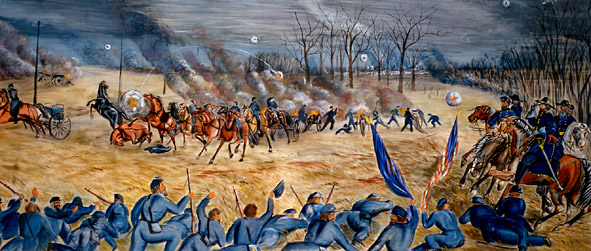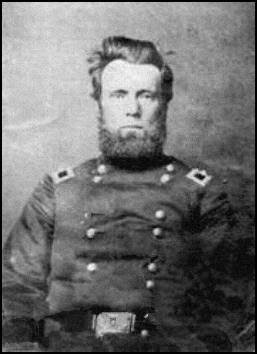Time for the 19th to try its grit: The 19th Ohio at Stones River
The 19th Ohio Volunteer Infantry was featured on this blog many months ago as being one of the quintessential regiments of the Army of the Cumberland, serving in its ranks almost from pillar to post during the Civil War. The 19th Ohio first met General William S. Rosecrans during the western Virginia campaign in the summer of 1861, and first fought under his flag at the Battle of Rich Mountain on July 11, 1861. In that engagement, Rosecrans had sent three Indiana regiments to charge a Rebel encampment and when they wavered, he reluctantly sent in the 19th Ohio. Rosecrans had previously derided the 19th Ohio as a "band box regiment" so when they went into action, the men felt they had something to prove. Maneuvering into position, the regiment delivered two devastating volleys that broke the Confederate line and won for the regiment Rosecrans everlasting respect. (see the full story here)
Fast forward to December 31, 1862- the right wing of Rosecrans army is broken and falling back and the Confederates were surging towards the Nashville Pike when Colonel Samuel Beatty's brigade, including this same 19th Ohio, arrives on the field ready to fight. Rosecrans must have smiled when he saw the flags of the old "band box regiment" from western Virginia days. Rosecrans had come to rely upon them and now placed them in a critical spot of his battle line to save the Nashville Pike. Sergeant Alfred Stambaugh of Co. F recalled that "at this moment General Rosecrans came riding up at full gallop and alone, not an aide with him, and said to Major Charles Manderson, “Form a junction with that brigade in the woods quick quick.” We immediately started for the new position and he quaintly said, “Hurry, and you give them hell.”
Stambaugh's account of the battle of Stones River originally saw publication in the February 28, 1863 edition of the Ohio Repository published in Canton, Ohio.
Camp near Murfreesboro, Tennessee
January 1863
I will now try and give you a few
particulars of the late fight. On the 29th of December 1862, the
Rebels halted us three miles from Murfreesboro and made a stand. It was then
near night and we went into camp. The next morning the ball was opened by heavy
picket firing in the center which soon brought on heavy cannonading which
boomed continually from noon until night. We still kept the position we
occupied the evening previous. The next morning December 31st our
regiment was formed in line of battle. Major Charles Manderson, commanding our
regiment, then said, “Boys, today the blow will be struck. Be cool, be brave,
and aim low.” Marching orders were then given; we were led by Colonel Samuel Beatty
and took our position on the extreme left. After crossing a creek, skirmishers
were deployed who soon run up against the Rebels and now and then a shot was
fired, the pickets advancing and we followed up slowly.
At
this time one of Beatty’s aides came riding up to our major and said “The
Rebels have got in our rear, cross the creek as quick as possible.” We did so
at a double quick when we came to the creek we went through kiting. Heavy
firing was going on on our extreme right (as I thought) but it was in our rear,
our lines then charged. Oh heavens, what a sight! Thousands upon thousands of infantry
double quicking across the plain- artillery rolling with the swiftness of
horses, while the musketry was roaring and shells bursting in every direction,
killing horses and men and knocking everything to pieces near them. We would
double quick one way, then another, and came to a halt, front, and then start
again for another position. At last, we double quicked into a corner of a cedar
forest. It was on this march that Frederick G. Feller was wounded in the leg by
a ball fired at the time in front of us. After we got in the forest, the line
in front gave way and came toward us- the Rebels following up with a deadly
fire, we opened our files and the retreating line passed through to our rear;
then was the time for the 19th to try its grit. The command to fix
bayonets and fire was given when a most stupendous rattle of musketry
commenced- we poured it into them. They stood like steel for about ten minutes
when their line gave way.
Our
regiment never flinched. Company F has brave men, they fired till the sweat
rolled from them. I looked to the right of the company and saw Gable from
Dundee lying dead. Collins and Milton were wounded. My place was in the rear of
the company as file closer, but the boys needed no telling to keep them in
line, more brave and resolute men I never saw. During that contest I fired 23
rounds, three of which were at the Rebel flag which did not wave long in
anyone’s hand. Our cartridge boxes were nearly empty when the Rebels hastily
fell back. We then gave a cheer that resounded for miles. Major Manderson waved
his hat and complimented us for our cool bravery.
"The ground blubbered under my feet like hot mush in a pot. The men fell dead and wounded all around me. It did appear to me as if my life was suspended upon the point of a needle." Sergeant Alfred W. Stambaugh, Co. F, 19th Ohio Volunteer Infantry
While
we were engaged, the 79th Indiana were lying in our rear. They were
anxious for a trial. They passed us and followed the Rebels up. We were then on
the second line and about 200 yards in the rear. The Rebels fell back across a
long field and made a stand in the thick woods. The 79th Indiana
poured volley after volley into them. Our regiment lay down in order to escape
the bullets that were whizzing over us, at this time the left wing of the 13th
Ohio formed a junction with our right. All at once the front line gave way and
fell back in considerable confusion. Then came another trying time. I soon saw
that our lines were exposed to an enfilading crossfire, so we too were compelled
to fall back under a perfect hailstorm of bullets. The ground blubbered under
my feet like hot mush in a pot. The men fell dead and wounded all around me,
but don’t affect one in the least under such a fire. I only thought of myself.
It did appear to me as if my life was suspended upon the point of a needle. We
fell back about 200 yards, rallied into line, and commenced firing.
Our
artillery was in the rear of us on a small eminence which opened and poured
grape into the Rebels over our heads with an awful whizzing and shaving the
branches of trees in front of us. At this moment General Rosecrans came riding
up at full gallop and alone, not an aide with him, and said to Major Manderson,
“Form a junction with that brigade in the woods quick quick.” He is the man for
me- he is as brave as a lion as he was in the hottest of the battle, no
difference where. We immediately started for the new position. He quaintly
said, “Hurry, and you give them hell.” But no Rebels came. We remained there
the balance of the day. Some hard fighting was done late in the evening on the
extreme right by the cavalry of both parties. We remained in the woods until
about midnight that night when we were moved to the left of the night. The next
morning January 1st we moved still further to the left, crossed the
creek and took our position in the second line, the right of our regiment
resting on the creek. Nothing in particular transpired save the exchange of
some cannon shots while picket firing was almost continual. This day passed
without a fight and the next till 3:30 in the afternoon when the Rebels made a
dash on our front. Musketry soon became general and we were ordered to lay down
to escape the stray bullets; again our line was compelled to fall back.
Our
brigade was ordered to arise and advance; we did so up a pretty steep grade,
but our front still continued to fall back. The Rebels followed up and poured a
destructive fire into our ranks. We fired one round and our line too was
compelled to give way to the overwhelmingly superior force of the enemy. Every
man then started for himself and the Rebels for us all. I stopped twice to see
if they were still coming- they did come by thousands. The trouble was our
brigade had to cross the creek which was about waist deep. By the time we had
crossed over, our reserve came on in strong force. The Rebels came no further
than the creek. Some of our boys did not cross, but played dead till we drove
the Rebels back. Five of our company were taken prisoners at the creek or while
on the way to it; they are Edward Catton, Robert Slater, David Weimer,
Alexander Navagon from Shanesville and Absalom Ganser of New Bedford. It
tickles me when I think of Ed Catton; he fought like a tiger. I guess the
Rebels thought they got a good one when they got Ed as he is so big and fat.
 |
| Major Charles F. Manderson 19th Ohio |
Our
knapsacks were piled up where we lay before we went into the second fight. The
Rebels charged upon them but we did not give them time to rifle them, mine at
least came out all right. Some of the boys found bullets that were buried in
them. It is strange that any of us got through safe. Every tree in the woods
was pierced. Our regiment had some 40 killed and about 125 wounded- total
killed, wounded, and missing of 220, just about 50 per cent of the regiment. A few more such battles will clean out the 19th
Ohio at such a rate. But don’t be alarmed: we will fight as long as we can
wiggle.
I am not particularly anxious for another such a fight, but I won’t flinch as long as I conceive it my duty to stand up to it. Lieutenant Keel was wounded pretty severely in the right arm. At one time my gun was knocked out of my hands which caused my right thumb to be numb for some time. Jacob Roush had his bayonet shot off clean. David Balcum of Milton had a bullet pass through his overcoat and blouse slightly grazing the skin. I could mention a great many narrow escapes but I must close.
Source:
Letter from Sergeant Alfred W. Stambaugh, Co. F, 19th
Ohio Volunteer Infantry, Ohio Repository (Ohio),
February 28, 1863, pg. 2













Comments
Post a Comment